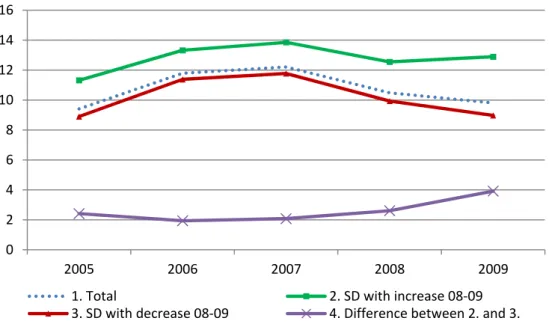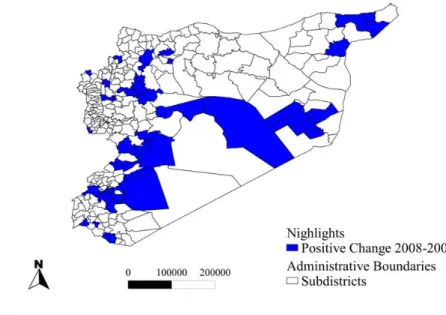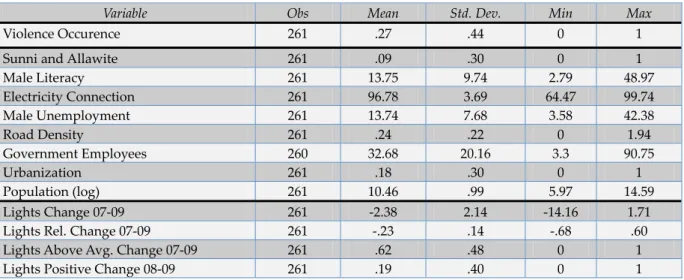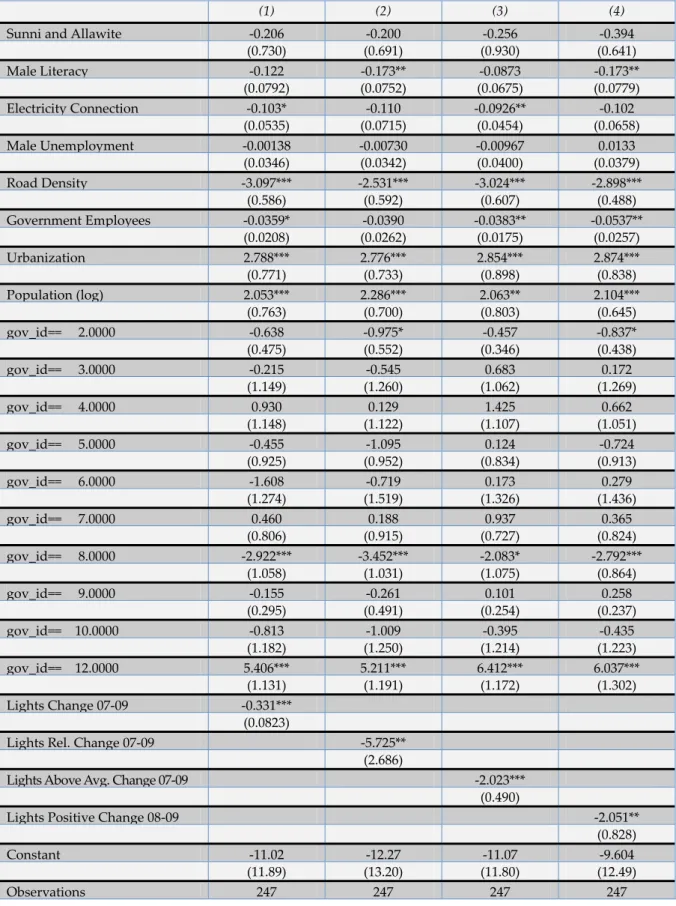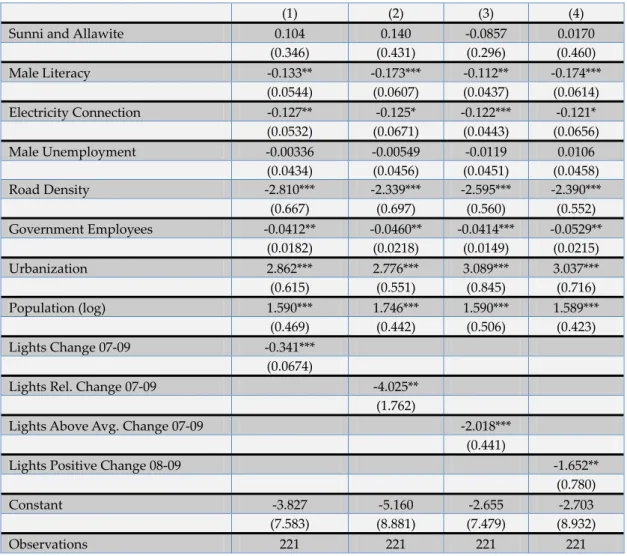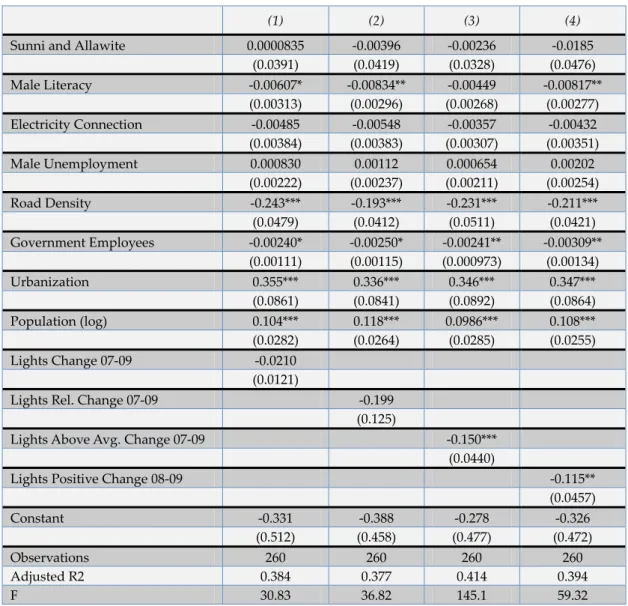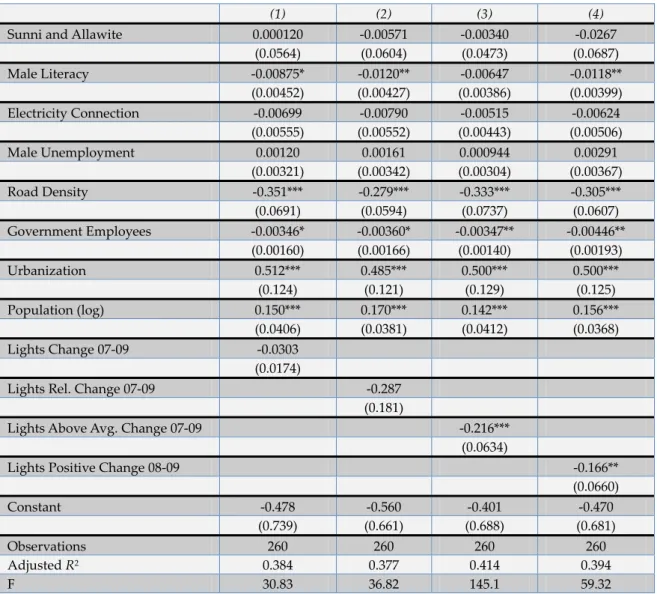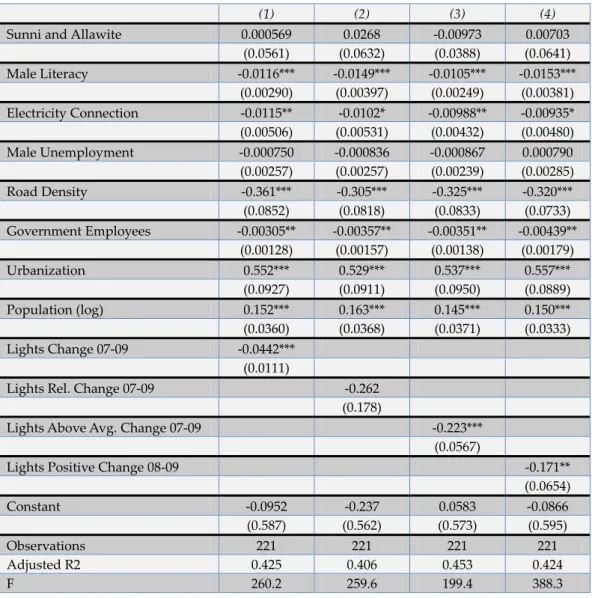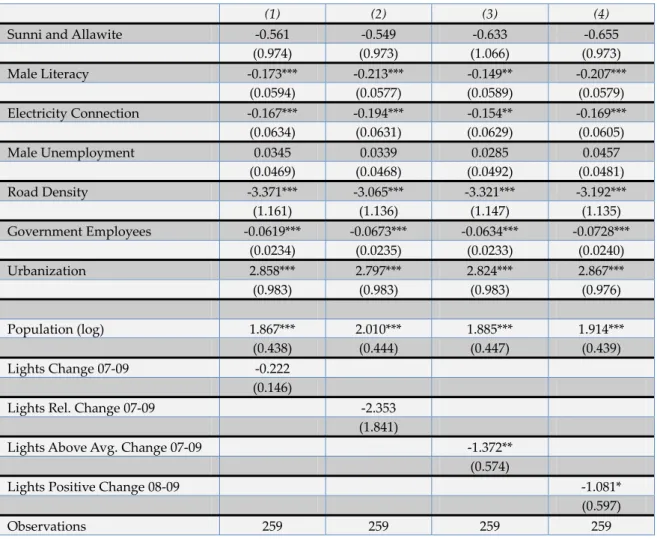orking Papers serve to disseminate the research results of work in progress prior to publicaton to encourage the exchange of ideas and academic debate. orking Papers series does not constitute publication and should not limit publication in any other venue. Copyright remains with the authors.
GIGA Research Programme:
Violence and Security
___________________________
The Effects of Regime Cooptation
on the Geographical Distribution of Violence:
Evidence from the Syrian Civil War Alexander De Juan and André Bank
No 222 May 2013
Edited by the
GIGA German Institute of Global and Area Studies Leibniz‐Institut für Globale und Regionale Studien
The GIGA Working Papers series serves to disseminate the research results of work in progress prior to publication in order to encourage the exchange of ideas and academic debate. An objective of the series is to get the findings out quickly, even if the presenta‐
tions are less than fully polished. Inclusion of a paper in the GIGA Working Papers series does not constitute publication and should not limit publication in any other venue. Copy‐
right remains with the authors. When working papers are eventually accepted by or pub‐
lished in a journal or book, the correct citation reference and, if possible, the corresponding link will then be included on the GIGA Working Papers website at
<www.giga‐hamburg.de/workingpapers>.
GIGA Research Programme “Violence and Security”
Copyright for this issue: © Alexander De Juan and André Bank WP Coordination and English‐language Copy Editing: Errol Bailey Editorial Assistance and Production: Silvia Bücke
All GIGA Working Papers are available online and free of charge on the website
<www.giga‐hamburg.de/workingpapers>.
For any requests please contact:
E‐mail: <workingpapers@giga‐hamburg.de>
The GIGA German Institute of Global and Area Studies cannot be held responsible for errors or any consequences arising from the use of information contained in this Working Paper; the views and opinions expressed are solely those of the author or authors and do not necessarily reflect those of the Institute.
GIGA German Institute of Global and Area Studies Leibniz‐Institut für Globale und Regionale Studien Neuer Jungfernstieg 21
20354 Hamburg Germany
E‐mail: <info@giga‐hamburg.de>
Website: <www.giga‐hamburg.de>
Geographical Distribution of Violence:
Evidence from the Syrian Civil War
Abstract
Is violent opposition less likely to occur in subnational regions that have been treated preferentially by the respective country’s ruling elite? Many authoritarian regimes try to secure political support by providing critical segments of the population with privileged access to economic or political rents. This study is interested in the effects of this strategy.
Our empirical analysis is based on crowdsourcing data on the number and geospatial dis‐
tribution of fatalities in the Syrian civil war. We also use satellite images of the earth at night to measure spatial variations in access to electricity across Syrian subdistricts; these data are complemented with information from the last Syrian population census. Estima‐
tions of fixed‐effects logit models confirm the hypothesis that the risk of violence has been lower in subdistricts that had been favored by the ruling regime in terms of preferential access to electricity in times of power shortages.
Keywords: Regime cooptation, geographical distribution of violence, Syria, civil war, crowdsourcing data, nightlights
Dr. Alexander De Juan
is a political scientist and research fellow at the GIGA Institute of Middle East Studies.
Contact: <alexander.dejuan@giga‐hamburg.de>
Website: <http://staff.en.giga‐hamburg.de/dejuan>
André Bank, M.A.
is a political scientist and research fellow at the GIGA Institute of Middle East Studies.
Contact: <andre.bank@giga‐hamburg.de>
Website: <http://staff.en.giga‐hamburg.de/bank>
Geographical Distribution of Violence:
Evidence from the Syrian Civil War
Alexander De Juan and André Bank
Article Outline 1 Introduction
2 The Role of Cooptation in Political Stability 3 Conceptualizing and Measuring Cooptation 4 The Case of Syria
5 Design, Data and Results 6 Conclusions
Bibliography
1 Introduction1
Ruling elites cannot maintain their grip on power through violence and repression alone. Re‐
cent events of the Arab Spring in the Middle East demonstrate that even the strongest security apparatuses cannot ensure political stability if elites do not have a minimum degree of legit‐
imacy among the population. In this sense, the selective provision of public goods2 has been
1 We thank Fritz Rickert for his very good research assistance. We are also grateful to Ariel Ahram, Viola Lucas, Jan Pierskalla and Stephan Rosiny for their helpful comments on previous versions of this paper. A previous ver‐
sion of this paper has been presented at the International Studies Association (ISA) Annual Convention 2013.
2 In line with Bueno de Mesquita et al. (Bueno de Mesquita, Smith, and Morrow 2003) we define “public goods” as goods available to all members of a society, whereas “private goods” are available to selected members only.
emphasized as an essential instrument for generating societal support or at least acquies‐
cence. This sees ruling elites provide political or material rents to critical segments of the population in order to either buy‐off opposition or reward loyal supporters.3 If done effec‐
tively, such redistribution encourages compliance and reduces the risk of violent resistance.
This paper aims to investigate this claim empirically.
A number of studies have found general evidence of the effectiveness of cooptation in this regard (e.g. Bethke and Bussmann 2011; Fjelde and Soysa 2009; Taydas and Peksen 2012).
We argue, however, that these studies share an essential shortcoming: their aggregated char‐
acter prevents them from adequately capturing what they claim to investigate. More specifi‐
cally, their cross‐country focus does not allow for the consideration of a crucial element of cooptation: the very selective and targeted nature of the redistribution of resources. More often than not, the provision of material goods is not used as an instrument to instill support among the masses per se, but rather to win or sustain the backing of specific segments of the population that are deemed particularly relevant for upholding political stability.
We seek to contribute to this debate by investigating the role of material redistribution in the subnational variations in political violence in Syria, scene of the most intense civil war in the context of the Arab Spring. Rather than investigating overall levels of spending or of the provision of public goods, we analyze the effects of actual preferential treatment of specific subnational regions. In other words, we want to ascertain whether Syrian subdistricts are less at risk of experiencing violence in the current civil war if they have been favored by the state in the distribution of scarce material resources in the recent past.
Authoritarian regimes in the Middle East and elsewhere have been particularly reluctant to provide meaningful socioeconomic information. Therefore, we mainly built our analysis on data that is out of the reach of the state. First, we made use of so‐called crowdsourcing data on the number of fatalities in the Syrian civil war; these data stem from decentralized reports filed by Syrians through a publicly accessible online platform. Second, we used digitized high‐resolution satellite images of the earth at night to measure spatial variations in the ac‐
cess to electricity across Syrian subdistricts. We complemented these data with information from the last Syrian population census undertaken in 2004 to build a new dataset of Syria’s 274 subdistricts. We performed cross‐sectional logit estimations, including fixed effects on the level of the country’s 14 governorates. Our findings confirm the hypothesis that the risk of violence has been lower in subdistricts that had previously been favored by the ruling re‐
gime in terms of access to electricity in times of severe power shortages.
Our results contribute to ongoing discussions in various ways: To the best of our knowledge, we are the first to undertake a systematic study on the role of redistribution in
3 We use “cooptation” as a general term referring to the preferential treatment of groups or regions by the rul‐
ing elite, with the aim of garnering or upholding political support. The term is usually associated with prefer‐
ential treatment of potential opposition only. However, for the sake of simplicity, we also subsume preferen‐
tial treatment of the elites’ support base under the term.
political violence on the subnational level. Focusing on the allocation of material resources in times of scarcity, we propose an innovative approach for the conceptualization of cooptation.
Complementing comparable cross‐country studies, we lend robust support to the hypothesis that cooptation can be an effective tool for encouraging compliance and reducing the risk of violent opposition.
Our paper proceeds as follows: In the second and third sections, we sketch previous the‐
oretical and empirical studies on the role of cooptation in political violence. Based on this re‐
view, we define our research interest, develop our main theoretical argument and present the conceptualization of our variables. The fourth section introduces the case of Syria, de‐
scribing the background of the ongoing civil war, the corner stones of the regime’s strategy of cooptation and essential characteristics of the country’s energy sector. The fifth section de‐
scribes the design, data and results of our empirical analyses. The final section summarizes our main arguments and findings.
2 The Role of Cooptation in Political Stability
Ruling elites need to secure support from among the population in order to reduce the risk of violent opposition. Certainly, repression plays a major, and possibly more important, role in securing compliance for many regimes. However, no government is likely to survive in the long run without a minimum degree of popular legitimacy. As Levi (2006: 7) argues, “quasi‐
voluntary compliance” – that is, people’s willingness to cooperate – is essential for political stability. This kind of compliance can only be generated if the population receives something in return (Levi 2006). Most research on the role of such regime cooptation has emphasized the importance of political rents. However, ruling elites may also try to win and uphold sup‐
port by providing material incentives, such as sharing economic benefits or implementing specific tax rates (Acemoglu, Verdier, and Robinson 2004; Gandhi and Przeworski 2007).
Thus it has been argued that a state’s ability to provide such goods reduces the risk that it will experience violent conflict. Notably, Bueno de Mesquita et al. (2003) argue that public spending can be used to “buy” allegiance and thus reduce the risk that the people will sup‐
port challengers to the ruling elite.
Various empirical studies have investigated the role of the provision of public goods in political violence. The findings, however, are mixed. For instance, Taydas and Peksen (2012) find a significant negative connection between welfare spending and civil conflict onset, whereas Fjelde (2009) presents evidence revealing that regime cooptation in oil‐rich states reduces the risk of violent opposition often associated with resource‐rich economies (see also Fjelde 2010; Fjelde and de Soysa 2009). Performing analyses along the same line, Bussmann (2009) and Bethke and Bussmann (2011) do not find any significant association of state ex‐
penditure on health and education with the onset of violent conflict.
Although we acknowledge that these studies have greatly contributed to our under‐
standing of the role of public spending and the provision of public goods, we argue that they neglect a defining feature of cooptation: the very selective and targeted nature of goods pro‐
vision. In principle, leaders may try to provide benefits to the population at large. However, the higher the number of beneficiaries, the lower the absolute value of rents for each benefi‐
ciary, including the members of the ruling regime themselves. Distributing rents to more people reduces the value of the rent per person (North, Wallis, and Weingast 2006). For that reason, instead of distributing resources evenly and broadly, regimes tend to selectively dis‐
tribute them to a limited number of people, therefore basing their power on support among specific segments of the population (e.g. Acemoglu, Verdier, and Robinson 2004; Azam 2001;
Wintrobe 2000).
There is a lively debate in the field of political economy about the determinants of such allocations. Here, rulers can focus on rewarding the backbone of their support (Burgess et al.
2010; Kramon and Posner 2012; Weinstein 2011) or they invest their resources to win support from regions and segments of the population that either are not strongly affiliated to one specific political party (swing voters) or are strategically important (e.g. Arulampalam et al.
2009; Sheng 2009). Whereas these studies differ in what they assume to be rulers’ central strategies of redistribution, they all share a common argument: the subnational redistribu‐
tion of economic and political rents by incumbent governments is carried out with the strate‐
gic aim of maximizing political support from crucial segments of the population. This redis‐
tribution strategy is mirrored in variations of goods provision across subnational regions and administrative units.
Our analysis connects these insights from the studies on the nexus of regime cooptation and political violence with political economy research on the determinants of allocations of political and economic rents. Mirroring the inconclusive results of the latter, we assume that if a district is favored, it may be a consequence of various determinants – namely, because they are dominated by the ruling elite’s ethnic or religious groups, because they have a history of resistance against the regime or because of specific population constellations that consti‐
tute a potential risk (see Schady 2000). Thus, the common characteristic that defines what makes specific groups and/or regions beneficiaries of private goods is that they are perceived by the ruling regime as being specifically important for its hold on power. Therefore, rather than analyzing the determinants of strategic redistribution treatment, we focus on its effects.
Specifically, we attempt to establish whether the preferential treatment of specific subnational regions by ruling elites reduces the risk that these regions experience political violence.
Our main hypothesis can be summarized as follows: The better off a subnational region has been in terms of the public redistribution of material goods, the lower the likelihood that the region has experienced violence in intrastate conflicts. In keeping with the arguments on the effects of cooptation outlined above, we assume that people will be less likely to engage in protest and violence against the ruling regime in regions that have profited from its policy
in absolute and relative terms. People have an interest in upholding the status quo in order to retain their privileged position and may fear reprisals due to their proregime stance in the event the regime is toppled. The lower the support base of the opposition within a subna‐
tional region, the lower the risk that the region will be the locus of sustained antistate action (e.g. Wickham‐Crowley 1987) and the lower the risk that it will be targeted by the regime’s repressive measures.4
3 Conceptualizing and Measuring Cooptation
A variety of measures have been used to capture subnational variations in the redistribution of material goods – welfare spending and allocations are two prominent proxies (Bethke and Bussmann 2011; Taydas and Peksen 2012; Weinstein 2011). Such indicators, however, do not capture whether spending results in any actual benefit to the targeted population. Corrup‐
tion and inefficiency may prevent actual delivery and thus undermine cooptation attempts.
Another type of indicator that has been used is state‐sponsored infrastructure, such as roads and schools (e.g. Burgess et al. 2010; Vaishnav and Sircar 2009). However, the effective provi‐
sion of services entails two tasks: providing access to services (i.e., through infrastructure) and sustaining the delivery of these services. Defunct services may actually generate griev‐
ances rather than instill support. Violent demonstrations against power cuts in Pakistan and Iraq (Arraf 2010; Lahore and Islamabad 2012) demonstrate how important it is to consider the latter dimension.
Other studies have investigated redistribution based on indicators such as enrollment, literacy or child mortality rates. Provision of education or health care is, however, often shaped by the interventions of international actors such as NGOs or development coopera‐
tion agencies (Kramon and Posner 2010). Moreover, such outcome indicators are likely influ‐
enced by a variety of factors not directly related to the state and its policies. Consequently, it is hard to trace variations on such indicators back to specific policies of the state.
We use geographical variations in electricity flows in times of national power shortages to construct our indicators for cooptation. We believe that this conceptualization offers several potential advantages in comparison to other indicators presented above. First, using infor‐
mation on flows of power allows us to capture actual output of service provision. Second, contrary to other goods, electricity is in most cases more directly related to government ac‐
tion given that the ruling elites in many developing countries monopolize – or are at least
4 We assume that these associations will be particularly relevant in shaping geographical patterns of violence in early phases of intrastate conflict: the longer the conflict endures, the more military strategy will shape the spatial distribution of violence. Moreover, as the probability of an actual regime change increases, incentive structures of coopted regions will likely change. For swing regions in particular, it may become more promis‐
ing to side with the opposition in order to improve their postwar prospects. To account for such dynamics, we concentrate our analyses on the early phase of the Syrian uprising and the ensuing civil war.
heavily involved in – the electricity sector. Third, we believe that focusing on variations in the provision of this scarce good will allow us to capture selective redistribution more per‐
suasively. As argued above, in times of resource abundance, ruling elites may be inclined to carry out a mass cooptation strategy. However, the scarcer the resources to be distributed, the more important it will be to make decisions on who receives what. Thus, the allocation of goods in times of limited availability (e.g., the provision of electricity in times of national electricity shortfalls) should provide a clearer picture of the priorities of the ruling elite in terms of preferential treatment.
We argue that this conceptualization will allow us to capture subnational variations in regime cooptation. As has rightly been argued, it may be problematic to focus on one public good alone as patterns of redistribution may differ across various goods (Kramon and Pos‐
ner 2010). However, in the case of Syria, we posit that our indicator (i.e., the provision of electricity) not only captures one essential public good, but also offers an effective proxy for other forms of cooptation that are distributed according to the same logic. (We provide some anecdotal evidence for this claim when discussing the operationalization of our independent variable in the fifth section.) Thus, we investigate geospatial associations between variations in electricity flows in a time of power scarcity (2007–2009) and the likelihood of the occur‐
rence of violence during the Syrian civil war after 2011.
4 The Case of Syria
Before we describe the data and our empirical strategy, it is important that we introduce the case of Syria. First, we provide a short overview of the events that led to the civil war and shaped its course. Second, we illustrate the system of cooptation of the Baʹathist regime.
Third, we briefly sketch some essential features of the Syrian electricity sector.
4.1 Syria in the Arab Spring: From Uprising to Civil War
The initial protests in Syria were triggered in the southern city of Daraʹa in mid‐March 2011, when a group of teenagers were arrested and allegedly tortured for writing the motto of the Arab Spring (“al‐shaʹb yurid isqat al‐nizam” – “the people want the downfall of the regime”) on house walls. The teenagers’ families and tribal leaders demanded their release, but the lo‐
cal security forces denied this request. As a reaction, the families took their protest to the streets. In response, security forces shot at the demonstrators, costing numerous people their lives; this, in turn, caused further protests that resulted in the destruction of public facilities and private property. The regime attempted to quash the growing protests with massive re‐
pression but only succeeded in spreading the protests to the surrounding villages and cities in the southern governorate (Arabic: muhafaza, pl. muhafazat) of Hawran (International Crisis Group 2011a; International Crisis Group 2011b, 12–13).
Since March 2011, the protests have gradually spread to almost all governorates in Syria.
Initially and up until the foundation of the Free Syrian Army (FSA) in July 2011, the regime’s repression was the central driving mechanism behind the protests’ geographical and social spread. As the months went by, however, a clear militarization of the civil and peaceful an‐
tiregime protests could be observed (International Crisis Group 2012b; International Crisis Group 2012a). As a result, the narrative of an exclusively nonviolent protest, which had been propagated until the end of 2011, became obsolete. By early 2012, the violent political stand‐
off that had already begun to develop in the summer of 2011 had escalated into a massive civil war. Regime forces continued their assaults on the rebels’ positions with the primary aim of consolidating their strongholds in the center of Damascus and in the Alawi‐
dominated Northwest. They did, however, recapture the coastal city of Latakia early on and reconquer some districts in Homs and Idlib. The rebels, on the other hand, dominate the Syr‐
ian territories along the Turkish border, the areas around the central Syrian cities of Hama and Homs, the agglomeration of Damascus (especially its southern suburbs), the area around the southern city of Dara’a and the northeastern city of Raqqa. The armed opposition has been, however, unable to overthrow the regime by military means. The uprising’s increasing militarization – accompanied by its “confessionalization” along Sunni‐versus‐Alawi lines – has been countered by the regime’s sustained use of repressive measures, which have, since the summer of 2012, included the bombardment of residential neighborhoods in “liberated”
(i.e., opposition‐held) areas. During the period of March 2011 to early 2013, Syria’s unrest transformed from a semiurban, primarily peaceful civil uprising to a professionalized, vio‐
lent opposition that has led to a fragile, but highly violent stalemate.
4.2 Cooptation in Baʹathist Syria
In order to illustrate the role of selective distribution of economic and political rents in politi‐
cal control in Syria, we provide a short overview on how the regime has made used of this instrument in the past. The Baʹathist “revolution from above” (Hinnebusch 2001) in the 1960s signified a drastic shift in urban‐rural relations and in particular the “rise” of the rural pe‐
riphery. The transformation of the Syrian countryside was, however, an uneven process. For instance, the Baʹathist regime invested heavily in job creation, electricity, schooling and health services in those regions where it had a strong foothold – often via primordial ties – and which it considered crucial for political stability, while leaving the Kurdish‐dominated northeast region and the Bedouin‐dominated, east‐central desert region in a state of under‐
development. One notable example of a region that profited strongly from these measures is the governorate of Latakia, from which approximately 75 percent of the Alawi hail (Van Dam 2011: 9). Similarly, the southern region of Hawran (including the provincial town of Daraʹa), the northwestern rural regions around Aleppo and the northeastern area of Deir az‐Zour
have all profited from the Baʹathist regime’s cooptation strategy to shore up its support bases in different rural parts of the country (Perthes 1997: 183; for detailed figures Van Dam 2011).
Together with repression and legitimation, cooptation was a core technique of political control in Syria under Hafiz al‐Asad, who – after coming to power in November 1970 – con‐
tinued to reward those regions that constituted the traditional backbone of the regime (Perthes 1997: 181–185). Representing the more pragmatic and Syria‐oriented wing of the Baʹath Party, President al‐Asad developed good ties with the Sunni bourgeoisie in Damascus right from the beginning of his rule, which consisted of leaving the Damascene business community’s privileges largely untouched and even granting new ones via the so‐called in‐
fitah (the 1970s policy of economic liberalization). This, however, alienated the more radical elements of the Baʹath Party from the regime. Nevertheless, the cooptation strategy worked, as the conservative Damascene bourgeoisie remained largely silent – and thus loyal – in the context of the Sunni‐Islamist antiregime uprising from 1979 to 1982. At the same time, how‐
ever, a number of religious‐conservatives representing the souk (traditional market) in the northern city of Aleppo supported and, in some cases, even joined the rebellion; this can ar‐
guably be attributed, in part, to the fact that they had not been coopted in the same way as their Damascene peers.
In July 2000, Bashar al‐Asad succeeded his father to the Syrian presidency as well as to the leadership of the armed forces and the Baʹath party. Not only did he have to position himself in the inherited authoritarian system (Bank 2004; Hinnebusch 2011; Perthes 2004), Bashar al‐Asad also had to tackle a number of new socioeconomic and demographic chal‐
lenges. Throughout the first decade of the twenty‐first century, the Baʹathist regime under Bashar al‐Asad pursued wide‐ranging neoliberal economic reforms, including the privatiza‐
tion of state companies, a job halt in the state administration and the cutting of subsidies.
These measures produced harshly negative effects for large parts of the population (Abboud 2013; Haddad 2012; Hinnebusch 2012). However, the Baʹathist economic policies during this period did not only produce losers (Hinnebusch 2012, 99); savvy crony capitalists were pre‐
sented with business opportunities by virtue of their connections to Bashar al‐Asad and his entourage. These economic oligarchs extracted considerable wealth from their virtual mo‐
nopolies on newly opened business opportunities (Lyme 2012). The emergence of this newly coopted business elite in Syria in the early 2000s (Haddad 2012; Hinnebusch 2012) has coin‐
cided with a spatial shift between different geographical entities: the overall gap between the richest and poorest parts of the country widened drastically. Under Bashar al‐Asad, it was the inner cities of Damascus and Aleppo that really prospered.
Whereas liberalization clearly changed the face of cooptation, some relevant patterns re‐
mained intact. Many of those who benefitted from direct state support under Hafiz al‐Asad have also profited from the selective liberalization under the rule of his son. Thus in many areas, traditional relations of cooptation have been renewed by different means (e.g. Donati 2013: 38, 39). Moreover, in the years prior to the Arab Spring, the regime increasingly felt the
need to give clear signs that it was engaged in mitigating the negative consequences of liber‐
alization for the broader population. For that reason, President Bashar al‐Asad drew on the cooptation strategy of his predecessor by investing in development initiatives in rural re‐
gions in order to garner support. As the regime lacked the necessary resources for broad co‐
optation, it concentrated its efforts on regions deemed particularly relevant (ICG 2011: 6).5 Since 2011, such initiatives have been stepped up due to rising tensions and have seen the regime establish a social security fund for cash handouts, reduce taxes on basic goods and increase subsidies on heating fuel (Donati 2013).
Overall, the changes that have occurred since Bashar al‐Asad became president underline the end of mass‐oriented cooptation strategies by the Baʹathist regime but the continued im‐
portance of targeted cooptation as a technique for political control. The beneficiaries com‐
prise members of a new urban elite, traditional supporters of the regime and selected rural populations deemed crucial to political stability.6 As argued above, we are not concerned with investigating why specific regions have profited from preferential treatment by the re‐
gime; rather, by using information on the variation in the access to electricity, we are at‐
tempting to identify these regions and study how their special‐status role influenced their risk of experiencing violence in the early phase of the Syrian civil war.
4.3 Electricity Provision in Syria
The electricity sector in Syria is firmly in the hands of the state. Although announcements have been made regarding stepwise restructuring and privatization, the regime’s Ministry of Electricity and its subordinate agencies are currently the only relevant actors in the sector (World Bank 2009). The energy sector is not only controlled by the state, it has also tradition‐
ally played a pivotal role in the regime’s policy of cooptation. When the Baʹath party seized power in the early 1960s, it launched a massive campaign of service provision in order to drum up broad public support (Goulden 2011). As a consequence, the rate of electrification increased from 2 percent in 1963 to today’s impressive 99 percent (Goulden 2011: 193; World Bank 2009). Moreover, electricity has been heavily subsidized in order to make it affordable for the poorer segments of the population (World Bank 2009).
When electricity became a scarce resource during the years 2007–2009, the regime had to take decisions on allocation. According to information from the US Energy Information Ad‐
ministration, Syrian energy net consumption had been increasing rather steadily until it ex‐
5 The Fund for Rural Development in Syria (FIRDOS) is a case in point; it has been argued that the scheme, which had been implemented in 60 selected villages across six governorates, has been used to renew clientelist arrangements in rural areas (Donati 2013: 45).
6 It could be argued that in Syria – under Bashar al‐Asad – sectarian and, in particular, Alawi identity constitute a key mechanism that connects the new urban elite, traditional regime supporters and selected rural areas.
There is, however, a dearth of elite analyses corroborating or falsifying this assertion, especially when com‐
pared with the seminal studies on the presidency of Hafiz al‐Asad (Perthes 1997; Van Dam 2011).
perienced a substantial drop toward the end of the first decade of the twenty‐first century (EIA 2011). Qualitative accounts from this period confirm the electricity crisis and the sub‐
stantial power cuts that struck the country as a result of this scarcity (Economic Intelligence Unit 2008; Economic Intelligence Unit 2009a; Economic Intelligence Unit 2009b).7 Rather than attempting to ease the overall energy shortfall nationwide, the regime geographically identi‐
fied those regions that would receive electricity and those that would not. Power cuts were deliberately allocated, often previously announced through local newspapers (Oxford Busi‐
ness Group 2010). Furthermore, the Ministry of Electricity launched a tender for generators to account for reduced capacities of public networks in selected areas in 2009 (Economic In‐
telligence Unit 2009a; Economic Intelligence Unit 2009b). Given that the deliberate allocation of power cuts has also been reported since the beginning of the uprising in 2011,8 it comes as no surprise that the Ministry of Electricity has been added to the EU sanctions list due to its alleged use of power cuts as a means of repression (European Union 2012).
Due to the state’s control over electricity distribution, the regime’s history of using the electricity sector for cooptation and the alleged selective allocation of electricity flows, we ar‐
gue that redistributive decisions made by the ruling regime during the period of severe power shortages (2007–2009) should indicate which subdistricts have been particularly favored by the ruling elite.
5 Design, Data and Results
Our analysis is based on a newly generated dataset of Syrian subdistricts (Arabic: nawahi, sg.
nahiya). From the total of 274 subdistricts, we excluded the 9 Golan Heights subdistricts due to the specific political status of the region and our assumption that the conflict dynamics in this area may be influenced by aspects specific to the area and different from other regions in the country. Moreover, we discarded a further 4 subdistricts due to their geographic specific‐
ities: the island of Arwad and the 3 subdistricts of Haritana, Jerablus and Tall Daww, which each consist of two geographically separated areas. This left us with a total of 261 subdistricts out of 274, located in 13 of the country’s 14 governorates.
5.1 The Dependent Variable: Occurrence of Violence
Our dependent variable is the occurrence of violence during the first 18 months of the Syrian civil war from March 2011 to November 2012. To measure it, we made use of a data source
7 The background of the crisis is manifold. It is likely that while demand increased constantly, Syria’s own generation capacity has experienced decreases. Moreover, the electricity sector has traditionally suffered from major technical and nontechnical transmission and distribution losses (World Bank 2009).
8 In 2012 The Syria Report describes how the Ministry of Electricity increased and decreased power outages in various regions of the country (Syria Report, 9 July 2012, cited after Lyme 2012).
that has seldom been used for analyses of political violence: crowdsourcing data. The basic idea of crowdsourcing is to gather information in a decentralized way, relying on infor‐
mation provided by people “on the ground.” People input their observations by email or di‐
rectly through various online platforms. Such systems have been used in a variety of cases, notably for the observation of violence or electoral processes.9
We used the data from an open, online platform called Syria Tracker, which is part of the larger Humanitarian Tracker project – a nonpolitical, nonpartisan organization. According to the information provided on the website, the platform is predominantly administered by Arab American volunteers based in the United States. Reports on fatalities can be filed in Arabic or English and include information on the exact location (either by description of the location or pinpointing on a digital map). The Syria Tracker team claims to make all possible efforts to clean the data of duplications by comparing the information provided in the reports. More‐
over, information from various online sources is used to complement the events that have been reported via the Syria Tracker online platform.
There are various challenges associated with using such crowdsourcing data: The first is‐
sue relates to the nature of the organizations that report the data; all of them are biased to‐
wards the rebel opposition, which may influence the way killings are observed and reported.
The second issue is related to the way information is gathered. Because reports are to be filed by witnesses, particularly intense fighting may lead to the underreporting of deaths simply because there may be no surviving witnesses to document fatalities. Underreporting may also be an issue in rural, less developed areas where a lack of access to electronic media may cause fatalities to be reported less frequently. A third issue relates to bias across time; this is caused by the population’s increased awareness of the crowdsourcing online platforms, which results in an increase in the number of reports filed (Price, Klinger, and Ball 2013).
Despite these shortcomings and the potential risks associated with them, we have identi‐
fied three key reasons that legitimize the use of crowdsourcing data for our purposes. First, the crowdsourcing data on Syria provide a wealth of information on a complex and devastat‐
ing civil war about which very little systematic information exists. Second, to account for the potential selection bias associated with this specific source, we analyzed correlations across space and time between the crowdsourcing data and another data source that relies on local networks of informants – that is, the Violations Documentation Centre. The high correlations we found strengthened our confidence in the crowdsourcing data.10 Third, we are confident
9 For example, to monitor elections in Liberia (online: <www.liberia2011.ushahidi.com/>, 21 February 2013), vi‐
olence in Sudan (online: <https://jan30sudan.crowdmap.com/>, 21 February 2013) or postelection violence in Kenya (online: <http://legacy.ushahidi.com/>, 21 February 2013).
10 We have calculated the correlation between the number of fatalities recorded by Syria Tracker and Violations Documentation Centre per month per governorate for the period from March 2011 to November 2012. The correlation coefficient (Pearson) is extremely high (0.90). Both sources vary in the sum of recorded fatalities. In some governorate/months one source reported a higher number, in other governorate/months it was the other source. This mirrors results from Price et al. (2013).
that our specific approach of analysis reduced the risks associated with some specific types of selection bias. Notably, we mitigated the potential risks associated with temporal bias by performing cross‐sectional analyses only. Furthermore, we reduced the potential problems emanating from inaccuracies with regard to the exact numbers of reported deaths. We did not consider differences in intensity levels but relied on a binary variable of violence occur‐
rence. Additionally, as regards potential geographical selection bias, we included a series of control variables into our analyses (see below).
For our main dependent variable, we collapsed fatality data into a binary indicator for occurrence of violence for the entire period of analysis ranging from the beginning of the up‐
rising in March 2011 to November 2012. We set the threshold for positive coding of the varia‐
ble at 25 reported deaths – in line with analogous country‐level thresholds (Gleditsch et al.
2002).11 The following illustration depicts the geographical distribution of violence occurrence across Syria’s subdistricts. Whereas we can clearly see clustering in western Syria along the North‐South axis of the country’s major cities, violence has also spread to other regions of the country. Our analyses aim to explain the puzzle of this specific geographical distribution.
Figure 1: Geographical Distribution of Fatalities in Syria, March 2011‒November 2012
Source: Author’s own compilation.
11 By collapsing fatality counts into a dichotomous variable we lose substantial amounts of potential information from the data. We assume, however, that the occurrence of violence may be driven by factors other than its in‐
tensity. Whereas preferential treatment by the ruling elite may play an important role in explaining where violence occurred, we assume that other factors are more relevant when it comes to explaining where violence has been particularly intense (De Juan 2012).
5.2 The Independent Variables: Access to Electricity
The Defense Meteorological Satellite Program’s Operational Linescan System provides data from high resolution satellite images of the earth at night, displaying geographical variations in observable nightlights in cities, towns and other sites with permanent lighting, including gas flares. Among others things, these pictures are used to produce annual composite images;
pictures containing clouds or ephemeral events are discarded. The respective digitized images contain information on the annual average brightness per 30 arc‐second grid. The data values per pixel range from 0 to 63 (NOAA 2013).
These data have been used before to construct indicators of electrification. Their specific benefit lies in the fact that they have been produced independently from local political inter‐
ference. Moreover, as argued before, they provide information beyond the availability of public electricity infrastructure – namely, on the regular flow of electrical power converted into observable outdoor lighting. The images provide comparable data on a yearly basis, al‐
lowing for consideration of temporal variations in light outputs (Min 2009). With 47 percent, the residential sector accounts for the biggest share of electricity consumption in Syria (World Bank 2009) – approximately 70 percent of which goes on lighting, refrigerators and televisions (Karaki et al. 2004). Overall, electricity is the main source for lighting in Syria.
Consequently, observable nightlights should be a good indicator of people’s actual access to electricity across time and across geographical areas.
As a first step, we used Geographic Information Systems software to generate the yearly mean light outputs for each Syrian subdistrict for the years 2005 to 2009 – the five most re‐
cent years for which nightlight pictures have been available from a single satellite.12 The overall temporal development corresponds to qualitative accounts of the electricity crisis, with overall light output decreasing from 2007 to 2009. Inspecting the light values more closely, we notice that light outputs diminished in nearly all subdistricts from 2007 to 2008.
However, some subdistricts started to recover in the period from 2008 to 2009, whereas most others suffered from further output losses. Figure 2 illustrates the development of the yearly mean light outputs for the total of all Syrian subdistricts, for those that gained from 2008 to 2009 and those that lost from 2008 to 2009. We see that overall the subdistricts represented by the upper (green) line have a higher mean light output and experienced less pronounced losses from 2007 to 2008.
Given these subdistricts’ mitigation of losses and the measures taken by the Syrian regime in 2008 and 2009 to counter the consequences of the crisis, we interpret these observations as fairly consistent indications that a specific group of subdistricts has been privileged in terms of
12 The light mean refers to the sum of the light values of all pixels within a subdistrict divided by the total num‐
ber of pixels. Thus by using mean values, we account for the differing size of subdistricts. Geoinformation on the location of subdistricts is taken from the Common and Fundamental Operational Dataset Registry website maintained by the UN Office for the Coordination of Humanitarian Affairs. Shapefiles generated by Syria Tracker are based on information retrieved from this site.
general access to electricity. Accordingly, we use these observable variations in light outputs as an indicator of the preferential treatment of some Syrian subdistricts by the ruling elite.
Figure 2: Development of Mean Nightlights in Syria, 2005‒2009
Source: Author’s own compilation.
More specifically, we constructed four different independent variables with the aim of cap‐
turing different facets of changes and differences in light outputs, thus increasing the robust‐
ness of our operationalization. The first indicator is the absolute change in mean light out‐
puts from 2007 to 2009. As the absolute losses or gains are likely influenced by the original light output in 2007, our second indicator is the change rate, dividing the absolute increase or decrease by the mean light output in 2007. The third indicator is a dummy variable that iden‐
tifies subdistricts that have lost less than the mean loss of all subdistricts between 2007 and 2009. The final indicator is a dummy variable differentiating between those subdistricts that experienced an increase in mean light outputs from 2008 to 2009 and those that did not. Fig‐
ure 3 plots this last variable to illustrate the spatial variations in increases and decreases of light outputs during the electricity crisis.
As argued above, we are not concerned with investigating the determinants of this spe‐
cific spatial pattern of redistribution. Nonetheless, as a means of scrutinizing the validity of our indicator, we provide some brief anecdotal evidence that the spatial patterns are plausi‐
ble in the light of previous accounts of the regime’s policy of cooptation.
0 2 4 6 8 10 12 14 16
2005 2006 2007 2008 2009
1. Total 2. SD with increase 08‐09
3. SD with decrease 08‐09 4. Difference between 2. and 3.
Figure 3: Nightlight Increases and Decreases of Syrian Subdistricts, 2008‒2009
Source: Author’s own compilation.
In general terms, the Alawi regions in the West and Northwest as well as the Druze‐domi‐
nated Hawran region in the Southwest have not been advantaged in terms of access to elec‐
tricity. These observations may seem counterintuitive in light of the dominant discourse on the sectarian support base of President Bashar al‐Asad and the fact that southwestern Syria had long been considered a main beneficiary of political and economic rents. However, as argued above, both regions had lost the preferential treatment they had enjoyed under the rule of Hafiz al‐Asad. Investments in jobs and the provision of basic services in Latakia and Hawran experienced a relative decline diachronically vis‐à‐vis the 1990s and synchronically vis‐à‐vis other governorates.
As expected, Aleppo and some of its outskirts show signs of preferential treatment dur‐
ing the energy crisis. This corresponds to the regime’s efforts to secure support in the city and its outskirts. On top of the massive investments in the city, Bashar al‐Asad appointed an Aleppine Syrian, Ahmad Hassun, as the new grand mufti in 2004; former prime minister Naji al‐Otri also hails from the city as do a number of other newer members of the elite. Fur‐
thermore, with Syria’s increasingly close business relations with Turkey under the AKP gov‐
ernment, Aleppo has become the central hub of bilateral trade between the two countries and an important location of industrial development (Tür 2011). It is very likely that the area’s history of dissent also played a major role in its preferential consideration by the ruling re‐
gime (International Crisis Group 2011b, 17).
Similarly, the northeastern regions in the governorates of al‐Hasaka and Dair az‐Zur suf‐
fered less energy losses in times of crises than other governorates. These regions are im‐
portant to the regime from at least three different points of view: First, substantial oil and gas fields are located in these areas. Second, Sunnis from these regions have played an essential
role as the backbone of the Syrian military, which creates strong incentives for the regime to secure at least a minimum support in their home governorates (Donati 2013). Third, al‐
Hasaka is a predominantly Kurdish region (in)famous for its restiveness, as evidenced by lo‐
cal riots in March 2004 and May 2005. When tensions rose in the region prior to the actual Syr‐
ian uprising, the regime reacted – in addition to increasing security services personnel – by implementing local cash‐payment schemes in the region (International Crisis Group 2011a: 6).
Further to the south, we observe that the governorates of Damascus and Homs have been particularly well‐off during the energy crisis. As argued above, the central neighborhoods of Damascus have been among the main profiteers of the regime’s policy. Under Bashar al‐
Asad, the city consolidated its position as the political and economic center of Syria (Interna‐
tional Crisis Group 2011a: 17). Similarly, Homs has enjoyed a rather privileged status. Several pilot projects have been launched in the region with the aim of turning the city into a national administrative center and the central hub on the crucial North‐South transportation axis. Fur‐
thermore, the regime holds close personal ties to the city with both the president and his brother, Maher, marrying into families from Homs (International Crisis Group 2011a: 18).
This anecdotal evidence supports our claim that variations in access to electricity during Syria’s energy crisis mirrors geographical variations in the regime’s strategic redistribution of economic rents.
5.3 Alternative Explanations and Control Variables
The indicators we used for our control variables mainly stem from the country’s last popula‐
tion census undertaken in 2004. Although social, economic and political features of the sub‐
districts may have changed in the seven‐year period between the census and the beginning of the uprising in 2011, we assume that this time span was too short for any fundamental changes in differences across subdistricts to have occurred. As our analyses only exploit such geographical variations, we are confident that the census data provide effective proxies for certain essential variables. If not explicitly stated otherwise, the information for our control variables come from the census.
The first control variable we included is population size. Countries and subnational ad‐
ministrative units display a higher risk of experiencing political violence the more people live within their boundaries; numerous studies have underlined this correlation (Collier and Hoeffler 2004; Raleigh and Hegre 2009). We included log‐transformed population size into our analyses in order to account for excessive variations in population size across Syrian subdistricts.
Our analyses focus on a specific type of violence. The Syrian civil war evolved out of mass protests that began in the country’s semiurban areas and eventually spread to the ur‐
ban centers of Homs, Hama, parts of Damascus and, finally, Aleppo. We therefore included information on subdistricts’ degrees of urbanization into our analyses. Following the thresh‐
olds used by the United Nations, our urbanization variable represents the share of the popu‐
lation living in cities with more than twenty thousand inhabitants.
The theoretical and empirical literature on political violence has emphasized the role of grievances stemming from low socioeconomic development (e.g. Do and Iyer 2010; Gurr 1993). We consider male literacy rates per subdistrict as a proxy for development levels. We decided to focus on male literacy rather than overall literacy rates in order to avoid potential distortions resulting from religio‐cultural variations in enrolment and literacy rates.
Our main independent variables can only mirror variations in the public provision of electricity if people primarily use power from public networks, rather than from private gen‐
erators. We thus included the share of people with access to the state’s electricity network as a control variable.
Studies that focus on opportunities for rebellion emphasize the role of factors that facili‐
tate recruitment into armed groups (e.g. Bohara et al. 2006; Collier and Hoeffler 2004). Un‐
employment is essential in this respect. People will more likely engage in violent action if their current and future economic perspectives are low. Therefore, we include information on male (see above) unemployment rates per subdistrict into our analyses.
Previous quantitative analyses on the subnational level demonstrate that violence is less likely in areas where the state maintains an effective presence (e.g. Buhaug 2010; Buhaug and Gates 2002). The Syrian census includes information on the share of people working for the state. We leverage this information to control for variations in state presence across subdis‐
tricts. Moreover, we use information on the Syrian road network provided by the UNDP. Us‐
ing GIS software, we calculated the number of road kilometers per subdistrict and divided it by the size of the respective subdistrict areas.
In many areas, violent clashes have displayed a strong sectarian dimension, pitting the Sunni majority against the Alawi minority. To the best of our knowledge, no reliable data ex‐
ists on the size of the various communities. As part of a larger mapping project (Gulf 2000), Michael Izady has generated a map displaying settlement areas of all religious communities (Izady 2012). We exploit the map to construct a dummy variable that takes on the value “1”
for subdistricts that enclose Sunni and Alawi settlement areas.
Although the census provides a series of relevant socioeconomic data, we did not have access to reliable data for other potentially relevant factors – for example, variations in the quality of the electricity grid, political affiliations of the executives of the regional power suppliers or the composition of the administration across the country’s 14 governorates. To account for these and other confounding social, economic or political variations, we included governorate‐level fixed effects into our model. More information on our empirical strategy is provided in the next section.13
13 We have investigated two other spatial variables: First, in order to consider spatial clustering of violence, we have calculated a variable that sums the number of fatalities in all neighboring subdistricts. Second, in the case of Syria, it has been emphasized that local smuggling networks in the southern and northern border districts
5.4 Model Specification and Results
Our basic dependent variable is the occurrence of violence leading to more than 25 deaths in the period ranging from March 2011 to November 2012. Analyzing a binary variable, we used logit models for our estimations. We included governorate‐level fixed effects. As part of our robustness checks described below, we performed alternative estimations using different models. Table 1 presents estimation results for all four variations of our independent variable in our primary model.
Table 1: Occurrence of Violence in Syrian Subdistricts, March 2011 to November 2012
(1) (2) (3) (4)
Sunni and Allawite ‐0.293 ‐0.254 ‐0.357 ‐0.410
(0.961) (0.946) (1.114) (0.950)
Male Literacy ‐0.108* ‐0.155*** ‐0.0760 ‐0.154***
(0.0575) (0.0572) (0.0580) (0.0566)
Electricity Connection ‐0.0958 ‐0.101 ‐0.0851 ‐0.0919
(0.0768) (0.0978) (0.0764) (0.0844)
Male Unemployment 0.000290 ‐0.00525 ‐0.00794 0.0129
(0.0524) (0.0517) (0.0553) (0.0530)
Road Density ‐2.893** ‐2.331** ‐2.806** ‐2.659**
(1.212) (1.130) (1.183) (1.176)
Government Employees ‐0.0318 ‐0.0352 ‐0.0345 ‐0.0482**
(0.0230) (0.0232) (0.0229) (0.0233)
Urbanization 2.564*** 2.547*** 2.610*** 2.606***
(0.970) (0.986) (0.993) (0.967)
Population (log) 1.865*** 2.070*** 1.869*** 1.887***
(0.453) (0.468) (0.469) (0.456)
Lights Change 07‐09 ‐0.313**
(0.150)
Lights Rel. Change 07‐09 ‐5.221*
(2.671)
Lights Above Avg. Change 07‐09 ‐1.879***
(0.614)
Lights Positive Change 08‐09 ‐1.824***
(0.705)
Observations 247 247 247 247
Standard errors in parentheses; * p < 0.10, ** p < 0.05, *** p < 0.01.
Source: Author’s own compilation.
have played a major role as resource for mobilization of resistance (Leenders and Heydemann 2012). Thus, we have controlled for the distance of each subdistrict’s center point to the nearest international border. As none of these variables has attained statistical significance in any of our models, we excluded them from our main analyses. Results for a complete model including both variables are reported in the Appendix.
